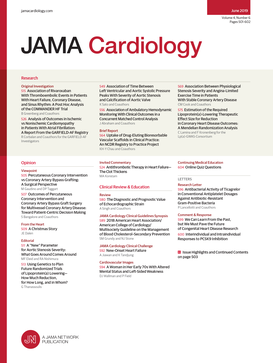Cardiovascular Health Among Rural and Urban US Adults—Healthcare, Lifestyle, and Social Factors
IF 14.8
1区 医学
Q1 CARDIAC & CARDIOVASCULAR SYSTEMS
引用次数: 0
Abstract
ImportanceImproving cardiovascular health in rural areas is a national priority in the US. However, little is known about the current state of rural cardiovascular health and the underlying drivers of any rural-urban disparities.ObjectiveTo compare rates of cardiometabolic risk factors and cardiovascular diseases between rural and urban US adults and to evaluate the extent to which health care access, lifestyle factors, and social risk factors contribute to any rural-urban differences.Design, Setting, and ParticipantsThis nationally representative cross-sectional study analyzed data from US adults aged 20 years or older residing in rural vs urban areas using the 2022 National Health Interview Survey. Data were analyzed between August 2024 and February 2025.ExposureCounty-level rurality.Main Outcomes and MeasuresThe primary outcomes were age-standardized rates of cardiometabolic risk factors (hypertension, hyperlipidemia, obesity, and diabetes) and cardiovascular diseases (coronary heart disease [CHD] and stroke).ResultsThe study population consisted of 27 172 adults, including 4256 adults (14.0%) residing in rural areas, 14 741 (54.8%) in small or medium metropolitan areas, and 8175 (31.2%) in urban areas. Mean (SD) participant age was 49.1 (17.8) years, and 4399 participants (50.8%) were female. Compared with their urban counterparts, rural adults were more likely to smoke, be insufficiently physically active, and have more social risk factors. Age-standardized rates of cardiometabolic risk factors were significantly higher in rural areas, including hypertension (37.1% vs 30.9%; rate ratio [RR], 1.20; 95% CI, 1.13-1.27), hyperlipidemia (29.3% vs 26.7%; RR, 1.10; 95% CI, 1.03-1.18), obesity (41.1% vs 30.0%; RR, 1.37; 95% CI, 1.27-1.47), and diabetes (11.2% vs 9.8%; RR, 1.15; 95% CI, 1.02-1.29). The same pattern was observed for CHD (6.7% vs 4.3%; RR, 1.58; 95% CI, 1.35-1.85), but no differences were observed for stroke. The magnitude of rural-urban disparities was largest among young adults (aged 20-39 years) for hypertension (RR, 1.44; 95% CI, 1.12-1.86), obesity (RR, 1.54; 95% CI, 1.34-1.77), and diabetes (RR, 2.59; 95% CI, 1.54-4.38). Rural-urban disparities in cardiovascular health were not meaningfully attenuated after adjustment for measures of health care access (insurance coverage, usual source of care, and recent health care utilization) and lifestyle factors (smoking and physical activity). However, accounting for social risk factors (poverty, education level, food insecurity, and home ownership) completely attenuated rural-urban disparities in hypertension (adjusted RR [aRR], 0.99; 95% CI, 0.93-1.06), diabetes (aRR, 1.02; 95% CI, 0.90-1.15), and CHD (aRR, 1.08; 95% CI, 0.91-1.29), but only partially attenuated disparities in obesity (aRR, 1.29; 95% CI, 1.20-1.39).Conclusions and RelevanceThis national cross-sectional study found substantial rural-urban disparities in cardiometabolic risk factors and cardiovascular diseases, which were largest among younger adults and almost entirely explained by social risk factors. These findings suggest that efforts to improve socioeconomic conditions in rural communities may be critical to address the rural-urban gap in cardiovascular health.求助全文
约1分钟内获得全文
求助全文
来源期刊

JAMA cardiology
Medicine-Cardiology and Cardiovascular Medicine
CiteScore
45.80
自引率
1.70%
发文量
264
期刊介绍:
JAMA Cardiology, an international peer-reviewed journal, serves as the premier publication for clinical investigators, clinicians, and trainees in cardiovascular medicine worldwide. As a member of the JAMA Network, it aligns with a consortium of peer-reviewed general medical and specialty publications.
Published online weekly, every Wednesday, and in 12 print/online issues annually, JAMA Cardiology attracts over 4.3 million annual article views and downloads. Research articles become freely accessible online 12 months post-publication without any author fees. Moreover, the online version is readily accessible to institutions in developing countries through the World Health Organization's HINARI program.
Positioned at the intersection of clinical investigation, actionable clinical science, and clinical practice, JAMA Cardiology prioritizes traditional and evolving cardiovascular medicine, alongside evidence-based health policy. It places particular emphasis on health equity, especially when grounded in original science, as a top editorial priority.
 求助内容:
求助内容: 应助结果提醒方式:
应助结果提醒方式:


